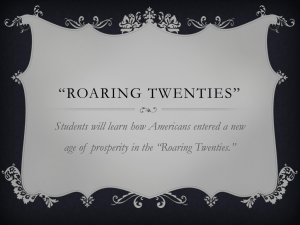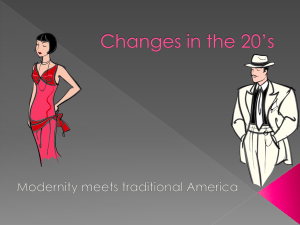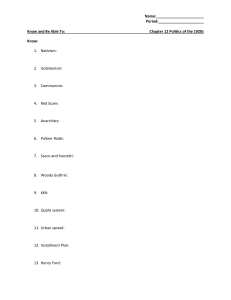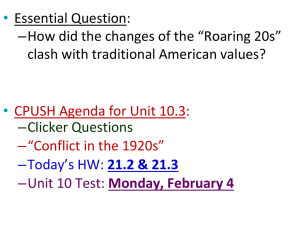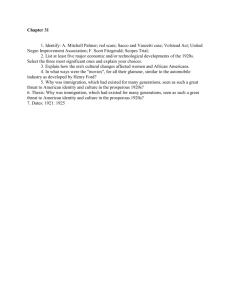Reading and Outlining: The 1920s
advertisement
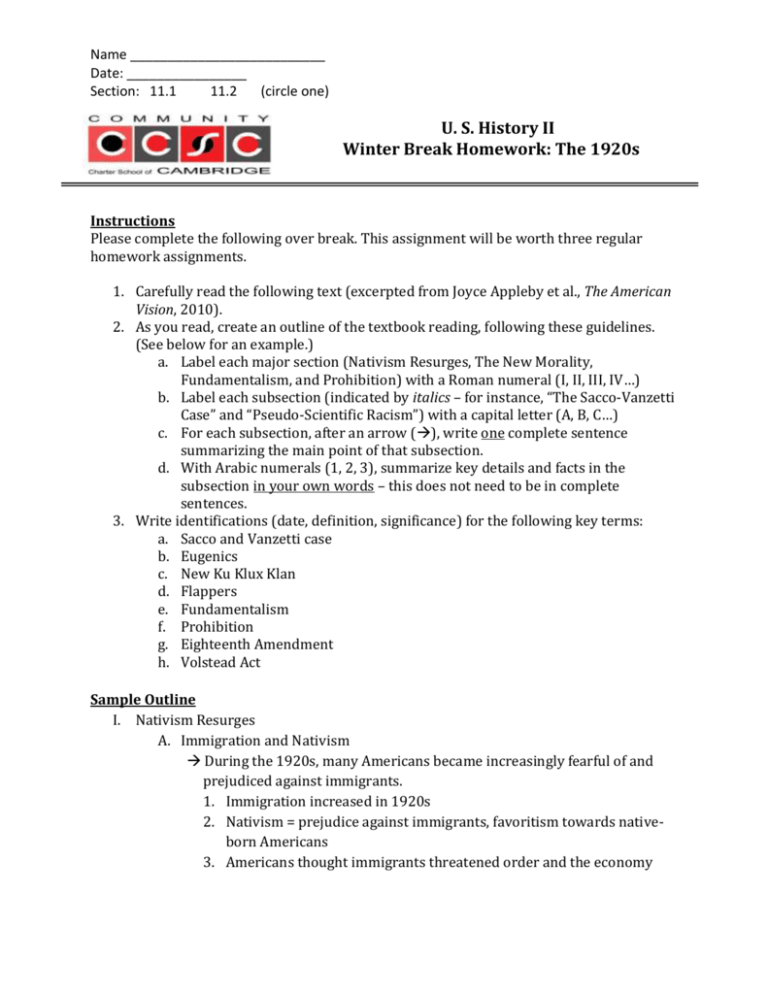
Name __________________________ Date: ________________ Section: 11.1 11.2 (circle one) U. S. History II Winter Break Homework: The 1920s Instructions Please complete the following over break. This assignment will be worth three regular homework assignments. 1. Carefully read the following text (excerpted from Joyce Appleby et al., The American Vision, 2010). 2. As you read, create an outline of the textbook reading, following these guidelines. (See below for an example.) a. Label each major section (Nativism Resurges, The New Morality, Fundamentalism, and Prohibition) with a Roman numeral (I, II, III, IV…) b. Label each subsection (indicated by italics – for instance, “The Sacco-Vanzetti Case” and “Pseudo-Scientific Racism”) with a capital letter (A, B, C…) c. For each subsection, after an arrow (), write one complete sentence summarizing the main point of that subsection. d. With Arabic numerals (1, 2, 3), summarize key details and facts in the subsection in your own words – this does not need to be in complete sentences. 3. Write identifications (date, definition, significance) for the following key terms: a. Sacco and Vanzetti case b. Eugenics c. New Ku Klux Klan d. Flappers e. Fundamentalism f. Prohibition g. Eighteenth Amendment h. Volstead Act Sample Outline I. Nativism Resurges A. Immigration and Nativism During the 1920s, many Americans became increasingly fearful of and prejudiced against immigrants. 1. Immigration increased in 1920s 2. Nativism = prejudice against immigrants, favoritism towards nativeborn Americans 3. Americans thought immigrants threatened order and the economy Nativism Resurges Immigration and Nativism. As the 1920s opened, an economic recession, an influx of immigrants, and racial and cultural tensions combined to create an atmosphere of disillusionment and intolerance. The fear and prejudice many felt toward Germans and Communists expanded to include all immigrants. This triggered a general rise in racism and in nativism, the desire to protect the interests of old-stock Americans against those of immigrants. During World War I, immigration to the United States had dropped sharply. By 1921, however, it had returned to prewar levels, with the majority of immigrants at this time coming from southern and eastern Europe. Many Americans saw immigrants as a threat to stability and order. The arrival of millions of immigrants also seemed to pose a threat to the four million recently demobilized military men and women searching for work in an economy with soaring unemployment and rising prices. As the new immigrants, many of whom were unskilled workers, sought to enter the workforce and establish a foothold in American life, many of them encountered ethnic and religious prejudices. The experience of two Italian immigrants, Nicola Sacco and Bartolomeo Vanzetti, exemplified the prejudices and fears of the period. The Sacco-Vanzetti Case. Shortly after 3:00 P.M. on April 15, 1920, two men shot and killed two employees of the Slater & Morrill Shoe Company in South Braintree, Massachusetts, and robbed the company of its $15,000 payroll. Police subsequently arrested Nicola Sacco, a shoemaker, and Bartolomeo Vanzetti, a fish peddler. The Sacco and Vanzetti case created a furor, as newspapers around the country revealed that the two immigrants were anarchists, or people who oppose all forms of government. They also discovered that Sacco owned a gun similar to the murder weapon and that the bullets used in the murders matched those in Sacco’s gun. Although no one at the time knew if Sacco and Vanzetti were guilty, many people leaped to that conclusion because the two men were Italian immigrants and anarchists. Others viewed the case as an example of prejudice against people based on their ethnic origin and political beliefs. On July 14, 1921, a jury found Sacco and Vanzetti guilty, and the judge sentenced them to death. Many Americans, caught up in the antiforeign fever of the time, applauded the verdict and the penalty. Over the next six years, lawyers filed numerous appeals for a new trial, but all were denied. In April 1927, a special Massachusetts commission studied the case and upheld the verdict. Four months later, on August 23, 1927, Sacco and Vanzetti were executed, proclaiming their innocence all the while. Pseudo-Scientific Racism. Nativist and racist feelings in the 1920s were reinforced by the beliefs of the eugenics movement. Eugenics is a pseudo-science (or false science) that deals with improving hereditary traits. Developed in Europe in the early 1900s, eugenics emphasized that human inequalities were inherited and warned against breeding the “unfit” or “inferior.” Eugenics fueled the nativists’ argument for the superiority of the “original” American stock—white Protestants of northern European descent. Political, intellectual, and cultural figures like Woodrow Wilson and Henry Cabot Lodge embraced eugenics. By doing so, they lent authority to racist theories, which reinvigorated the nativist argument for strict immigration control. Return of the Ku Klux Klan. At the forefront of the movement to restrict immigration was the Ku Klux Klan, or KKK. The old KKK had flourished in the South after the Civil War and used threats and violence to intimidate newly freed African Americans. The new Klan had other targets as well—Catholics, Jews, immigrants, and other groups believed to represent “un-American” values. William J. Simmons founded the new Ku Klux Klan in Atlanta, Georgia, in 1915. A former circuit-riding Methodist preacher, Simmons pledged to preserve America’s white, Protestant civilization. In the 1920s, Klan publicity claimed that the organization was fighting for “Americanism.” The Klan attracted few members until 1920, when Simmons hired public relations entrepreneurs Edward Young Clarke and Elizabeth Tyler, paying them a commission of $8 of every $10 initiation fee for a new Klan recruit. Clarke and Tyler divided the nation into regions and paid more than 1,000 “salespeople” to promote the Klan. As a result of their strategy, membership in the Ku Klux Klan exploded, reaching nearly 4 million by 1924 as it spread beyond the South and into Northern cities. The Klan began to decline in the late 1920s, however, largely as a result of scandals and power struggles involving its leaders. Membership shrank, and politicians whom the Klan supported were voted out of office. The sharp reduction in immigrants due to new immigration laws further disabled the Klan, depriving it of a major issue. The Klan never again had a major impact on politics. The New Morality Changes in Traditional Morality. Many groups that wanted to restrict immigration also wanted to preserve what they considered to be traditional values. They feared that a “new morality” was taking over the nation. Challenging traditional ways of seeing and thinking, the new morality glorified youth and personal freedom and influenced various aspects of American society. Ideals of the loving family and personal satisfaction—views popularized in magazines and other media—influenced popular views on relationships. As the loving and emotional aspects of marriage grew in importance, the ideas of romance, pleasure, and friendship became linked to successful marriages. Advice books in the 1920s dispensed such hints as, “Have lots of pleasure that both husband and wife enjoy . . . and above all, be good friends.” Women in the workforce also began to define the new morality. Many single, workingclass women held jobs simply because they needed the wages for themselves or for their families. For some young, single women, work was a way to break away from parental authority and establish a personal identity. Work also provided the wages that allowed women to participate in the consumer culture. Women who attended college in the 1920s often found support for their emerging sense of independence. Women’s colleges, in particular, encouraged their students to pursue careers and to challenge traditional ideas about the nature of women and their role in society. The automobile also played a role in encouraging the new morality. The nation’s youth loved cars because cars made them more independent and allowed them to escape the careful watch of their parents. Instead of socializing at home with the family, many youths could now use cars to seek new forms of entertainment with their friends and to find privacy. Women in the 1920s. Fashion changed during the 1920s, as women “bobbed,” or shortened, their hair, wore flesh-colored silk stockings, and admired the youthful look of movie stars. Though not typical of most women, the flapper—a young, dramatic, and stylish woman— personified these changes. She smoked cigarettes, drank prohibited liquor, and dressed in attire considered too revealing by many. Zelda Fitzgerald, wife of writer F. Scott Fitzgerald, symbolized the flapper spirit. She urged women to be “light-hearted [and] unconventional” rather than focused on “a career that calls for hard work.” While flappers pursued social freedoms, other women sought financial independence by entering the workforce, many of them as salesclerks, secretaries, or telephone operators. A few made contributions in science, medicine, law, or literature. In science, Florence Sabin’s medical research led to a dramatic drop in death rates from tuberculosis. In literature, Edith Wharton received the Pulitzer Prize for her novel The Age of Innocence. Public health nurse Margaret Sanger, believing that the standard of living could be improved if families limited the number of children they had, founded the American Birth Control League in 1921. This organization became Planned Parenthood in the 1940s. In 1928 Margaret Mead, one of the first woman anthropologists, published the highly regarded study, Coming of Age in Samoa, which described life in a Pacific island culture. The Fundamentalist Movement While many Americans embraced the new morality, millions more feared that the country was losing its traditional values. To these Americans, the modern consumer culture, relaxed ethics, and growing urbanism symbolized the nation’s moral decline. Many of these people, especially those in small rural towns, responded by joining a religious movement known as Fundamentalism—a name derived from a series of pamphlets titled The Fundamentals, published by oil millionaire Lyman Stewart. Fundamentalist Beliefs. Fundamentalists believed that the Bible was literally true and without error. They defended the Protestant faith against ideas that implied that human beings derived their moral behavior from society and nature, not God. In particular, Fundamentalists rejected Charles Darwin’s theory of evolution, which said that human beings had developed from lower forms of life over the course of millions of years. Instead, they believed in creationism—the belief that God created the world as described in the Bible. Two popular evangelical preachers, Billy Sunday and Aimee Semple McPherson, stirred Fundamentalists’ passions by preaching traditional religious and moral values in very nontraditional ways. A former professional baseball player, Sunday drew huge crowds with his rapid-fire sermons and on-stage showmanship. McPherson conducted her revivals and faith healings in Los Angeles in a flamboyant theatrical style, using stage sets and costumes that expressed the themes of her highly emotional sermons. The Scopes Trial. Evolutionists and creationists eventually clashed in a historic trial. In 1925 Tennessee passed the Butler Act, which outlawed any teaching that denied “the story of the Divine Creation of man as taught in the Bible,” and taught instead that “man descended from a lower order of animals.” The American Civil Liberties Union (ACLU) advertised for a teacher who would be willing to be arrested for teaching evolution. John T. Scopes, a high school biology teacher in Dayton, Tennessee, volunteered to be the test case. He taught evolution and was subsequently arrested and put on trial. The trial took place in the summer of 1925. William Jennings Bryan, a three-time Democratic presidential candidate, was the prosecutor and represented the creationists. Clarence Darrow, one of the country’s most celebrated trial lawyers, defended Scopes. After eight days of trial, Scopes was found guilty and fined $100, although the conviction was later overturned on a technicality. Parts of the trial had been broadcast over the radio, and Darrow’s blistering cross-examination of Bryan did little for the Fundamentalist cause. Increasingly, Fundamentalists found themselves isolated from mainstream Protestantism, and their commitment to political activism declined. Prohibition The movement to ban alcohol had been building throughout the late 1800s. By the early 1900s, many progressives and traditionalists supported prohibition. Many people believed the prohibition of alcohol would help reduce unemployment, domestic violence, and poverty. Their support helped pass the Eighteenth Amendment, which took effect in January 1920. To try to enforce the amendment, Congress passed the National Prohibition Act, also known as the Volstead Act. Enforcing Prohibition became the responsibility of the U.S. Treasury Department. Treasury agents had enforced federal tax laws for many years, but police powers—a government’s power to control people and property in the interest of public safety, health, welfare, and morals—had generally been reserved for the state governments. The Eighteenth Amendment granted federal and state governments the power to enforce Prohibition, marking a dramatic increase in federal police powers. The Treasury Department’s new Prohibition Unit struggled to enforce Prohibition. During the 1920s, treasury agents made more than 540,000 arrests, but Americans persisted in blatantly ignoring the law. People flocked to secret bars called speakeasies, where they could purchase alcohol. In New York City alone, an estimated 32,000 such bars sold liquor illegally. Liquor also was readily available in rural America, where bootlegging—the illegal production and distribution of liquor—was common. Organized crime specialized in supplying and often running these speakeasies, which popped up all over the country. The huge profits that could be made supplying liquor encouraged some people to become smugglers, bringing liquor into the United States from Canada and the Caribbean. Smuggling and the consumption of liquor by millions helped create an illegal billion-dollar industry for gangsters. More than 70 federal agents were killed while enforcing Prohibition in the 1920s. Crime became big business, and some gangsters had enough money to corrupt local politicians. Al Capone, one of the most successful and violent gangsters of the era, had many police officers, judges, and other officials on his payroll. Capone dominated organized crime in Chicago, where he ran bootlegging and other criminal rackets. Finally, Eliot Ness, the leader of a special Treasury Department task force, brought Capone to justice. The battle to repeal Prohibition began almost as soon as the Eighteenth Amendment was ratified. Supporters of repeal associated Prohibition with “priggish fanaticism.” The ratification of the Twenty-first Amendment in 1933 repealed the Eighteenth Amendment and ended federally-mandated Prohibition. It was a victory for the forces of modernism and a defeat for the supporters of traditional moral values.

